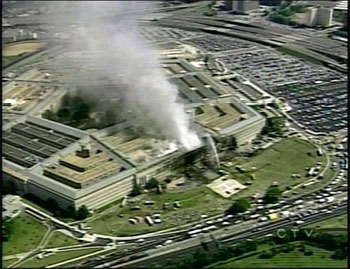© Constance J. Moore
Colonel, ANC (Retired), ANCA Historian
 At 9:38 a.m. on the morning of 11 September 2001 an American Airlines jet slammed into the Pentagon and sliced into its outer rings. Fire and smoke spread from the crash site. The structure and its lethal cargo of jet fuel ignited, burning offices, hallways and anything in its path. The intense heat, fire and smoke killed many instantly and drove thousands into the corridors of the five-sided headquarters.
At 9:38 a.m. on the morning of 11 September 2001 an American Airlines jet slammed into the Pentagon and sliced into its outer rings. Fire and smoke spread from the crash site. The structure and its lethal cargo of jet fuel ignited, burning offices, hallways and anything in its path. The intense heat, fire and smoke killed many instantly and drove thousands into the corridors of the five-sided headquarters.
The Chief Nurse of the DiLorenzo TRICARE Health Clinic, Major Lorie A. Brown, provided a chilling account of the first few minutes after the attack. She remembered, "Within three minutes of the crash, we knew what had happened ... hundreds and hundreds of people [were] running down the hallways or running out[doors] ... into the parking [lot]. And very quickly the smoke started piling in. I [tried] to muster our MASCAL [Mass Casualty] [personnel]—[to get them] organized [into casualty teams]."
Brown sent one emergency team into the center courtyard; another into north parking to establish a patient collection point on a grassy lawn near Boundary Channel Drive; and a third triage area was set up in the clinic. With their emergency bags already packed, and only the length of the hallway to run, Major Brown said, [the teams] "had all of the triage areas operational by 0943, 5 minutes after the plane hit the Pentagon." She continued, "By that time we had patients, ... I [was] getting reports—'I need O2 [oxygen],' 'I need splints,' 'We've got burns,' 'We need this,' 'We need that'—all via radio. And then I'm, 'Okay ... you get this,' 'You can do that,' 'You do this,' 'You go here,' 'Send this there'—making up more teams."1
First responders and health care professionals rallied to the building from nearby medical, police, and fire facilities to help survivors and to triage and treat the wounded. Brown elaborated further:
"Volunteers [were] coming in [saying] 'I'm a doc,' 'I'm a nurse,' 'I'm here to help. What can I do?' 'Okay, here's a vest, here's a bag.' There were ambulances lined up [on the other side of the building [with] few patients.
"[The clinic side of the building had many more critically injured. There were] no ambulances [on our side] in North Parking. So ... I evac[uate]d by civilian means. I stood up on top of a car and yelled, 'Anybody!' I said, 'Stop that car. Stop it now. Anybody with ... keys, anybody with an SUV.' We had the cars lined up, threw seats out of them, and put the patients with a doc[tor] or a nurse ... and sent them all to Arlington, which is the closest hospital."2
When all the patients in the north parking area had been evacuated, Major Brown focused on creating more medical teams, collecting medical supplies, and moving back to the center courtyard in order to reestablish a triage area. It was only 10:38 a.m., barely one hour after the attack.3
This brief account of Brown's response during the first hour of the disaster is but one situation report about that difficult day. Many heroic firemen, paramedics, police, and rescue personnel from the surrounding communities had equally as harrowing experiences. The crash took the lives not only of the terrorists, passengers, and crew on the airliner but also of 125 Pentagon workers: 72 from the Department of the Army, 43 from the Department of the Navy, and 10 from the DoD.
4 Healthcare professionals like Major Brown did not expected to see such carnage at the Pentagon, but they answered the call and cared for the casualties.
- Condon Rall, Mary Ellen. Attack on the Pentagon The Medical Response to 9/11, (Washington, DC: the Borden Institute, 2011): 14.
- Ibid, p. 15.
- Ibid, p. 28.
- Ibid, p. 5.